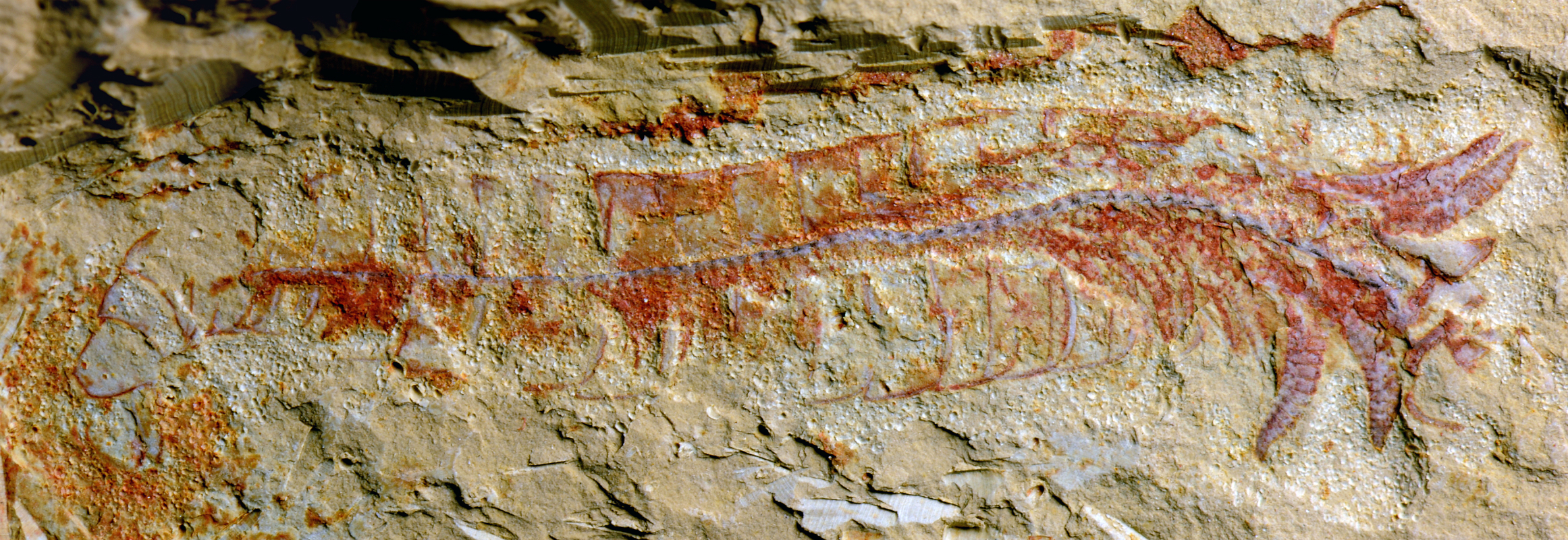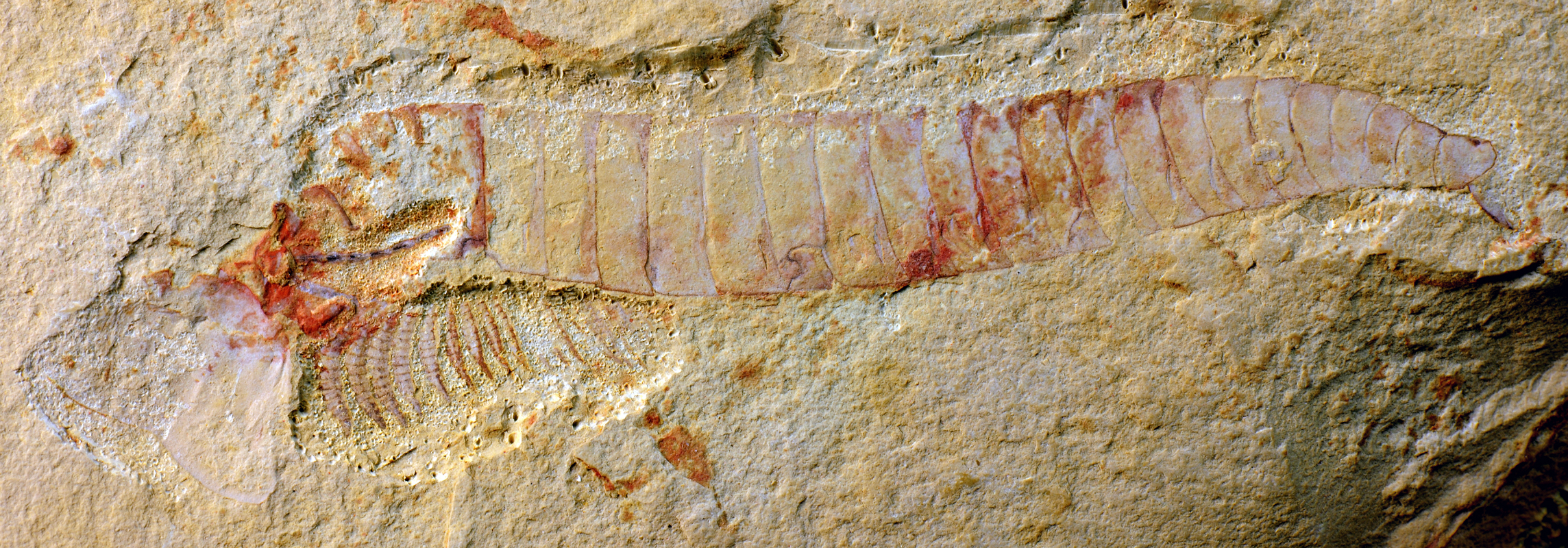Oldest Nervous System Found in 520-Million-Year-Old Fossil

Fossils of an ancient creature resembling a shrimp with an armored head contain the oldest and best-preserved nervous system ever found, which could help scientists decipher the evolution of nervous systems in animals alive today, according to a new study.
The remarkable remains belonged to Chengjiangocaris kunmingensis, a crustaceanlike creature that lived 520 million years ago in what is now South China. The fossils revealed a long "ropelike" central nerve cord that extended throughout the body, with visible clusters of nerve tissue arranged along the cord, like beads strung on a thread. Even individual nerve structures could be detected, the scientists discovered.
They noted that the nerve tissue masses, or ganglia, grew progressively smaller along the central nerve cord, with the smallest masses being the ones most distant from C. kunmingensis's head. The researchers also found that the ganglia were associated with pairs of legs, which also reduced in size as they progressed along the animal's body. [Fabulous Fossils: Gallery of Earliest Animal Organs]
Other structures in C. kunmingensis's nervous system — dozens of nerves that emerged at regular intervals from the nerve cord near the underside of the body — resembled those found in certain types of modern worms, but were absent in modern arthropods, offering clues to the scientists about how nervous systems adapted as different forms of life in these related lineages evolved.

Arthropod ancestors
C. kunmingensis lived during the Cambrian, the geologic period on Earth when life was rapidly diversifying, and they belonged to a group of arthropod ancestors called fuxianhuiids. These predecessors of insects, arachnids and crustaceans had armored heads and long, segmented bodies atop numerous pairs of legs — with three or four pairs per segment. These creatures likely scuttled across the sea bottom, scooping food into their mouths with a larger pair of limbs close to their heads, according to study co-author Javier Ortega-Hernández, a biologist in the Department of Zoology at the University of Cambridge, in the United Kingdom.
"Some of the largest individuals can reach up to 15 centimeters (6 inches) long, and they had at least 80 legs!" Ortega-Hernández told Live Science in an email.
Get the world’s most fascinating discoveries delivered straight to your inbox.
But until now, little was known about what they looked like on the inside. Fossils typically provide scientists with records of bones, teeth, shells and other tough organic structures, while softer tissues generally disintegrate too quickly to be preserved, and are lost to time. But sometimes conditions prevail that protect the more delicate organs, allowing them to fossilize as well.
According to Ortega-Hernández, the Xiashiba area in Kunming, South China, where the specimens were found, is "world famous" for preserving soft-bodied life. He explained that the animals were likely buried in fine sediment in an oxygen-poor environment, which would protect the carcass from both scavengers and microbes, slowing or even halting decay.
"Eventually the carcasses become preserved in the fossil record, and the limited decay allows for the preservation of amazing morphological detail," he said. [Photos: Ancient Sea Monster Was One of Largest Arthropods]

"Our jaws dropped"
Prior studies from this period described fossils providing evidence of these arthropod ancestors' brains, but this study is the first to describe a complete nervous system from this ancient time, and with a level of detail that has never been seen before, the researchers said.
When the scientists looked closely at the ganglia masses, they spied fibers that measured around five-thousandths of a millimeter in length — "less than [the width of] a human hair," Ortega-Hernández said.
"Our jaws dropped when we put the specimens under the microscope and observed the fine nerves on the sides," he told Live Science. "It was hard to believe that something so small would be preserved along with the main nerve cord, but even more so because they show a unique organization that is otherwise unknown in living arthropods."
This organization — nerve cord, ganglia and dozens of nerves extending along each side — is similar to the neural systems of modern arthropods, Ortega-Hernández said. But, in arthropods alive today, the number of fine nerves is significantly lower, he added.
The number of these nerves is higher in velvet worms — cousins to arthropods —which suggests this feature dates back to the last shared ancestor for these two groups.
"It is possible that as arthropods became more specialized in their function, they managed to make their nervous system more efficient by reducing the number of nerves," Ortega-Hernández said, adding that this is only a hypothesis. "But it will be an interesting topic to explore in future studies," he said.
The findings were published online today (Feb. 29) in the journal Proceedings of the National Academy of Sciences.
Follow Mindy Weisberger on Twitter and Google+. Follow us @livescience, Facebook & Google+. Original article on Live Science.

Mindy Weisberger is an editor at Scholastic and a former Live Science channel editor and senior writer. She has reported on general science, covering climate change, paleontology, biology and space. Mindy studied film at Columbia University; prior to Live Science she produced, wrote and directed media for the American Museum of Natural History in New York City. Her videos about dinosaurs, astrophysics, biodiversity and evolution appear in museums and science centers worldwide, earning awards such as the CINE Golden Eagle and the Communicator Award of Excellence. Her writing has also appeared in Scientific American, The Washington Post and How It Works. She is the author of the book "Rise of the Zombie Bugs: The Surprising Science of Parasitic Mind Control," published by Hopkins Press.
